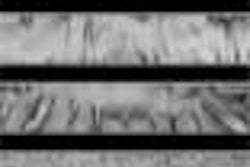The ability to sort out benign stomach conditions from malignancies is an important goal of imaging. Separating gastritis and ulcers from tumors has proved to be challenging, however, and studies to date have not succeeded in ruling out cases that do not require follow-up with barium or endoscopic examinations.
Writing in Radiology, Dr. Erik Insko, Dr. Marc Levine, and colleagues from the Hospital of the University of Pennsylvania in Philadelphia hoped to change all that with a retrospective study assessing sensitivity and specificity of contrast CT findings in patients with stomach lesions (Radiology, July 2003, Vol. 228:1, pp. 166-171).
"The results of several previously performed studies have shown that a normal gastric wall usually has a thickness of 5 mm or less at CT, whereas a gastric wall involved by tumor usually has a thickness of 1 cm or greater," the authors wrote. "We wondered whether the degree of gastric wall thickening combined with other criteria such as symmetry, distribution, and enhancement of the thickened gastric wall might enable radiologists to differentiate benign from malignant conditions at CT."
The study examined data from 36 patients (aged 35-80, mean age 52) who had undergone contrast-enhanced CT with findings of gastric wall abnormality, followed by further evaluation with barium-enema suspension exams of the upper gastrointestinal tract.
Thirty to 40 minutes prior to CT imaging, the patients received 600-800 mL of 2%-3% diatrizoate meglumine and diatrizoate sodium as an oral contrast agent, in addition to a 2.1% wt/vol barium suspension. An additional 400-500 mL of the oral contrast material was administered just before imaging.
All patients underwent CT of the upper abdomen on either a HiSpeed Advantage or HiSpeed CT/i scanner (GE Medical Systems, Waukesha, WI) using either 5- or 7-mm collimation, and a pitch of 1.5, or 7-mm collimation and a pitch of 1.3, mAs of 200-220. The group reconstructed transverse images using a soft-tissue algorithm, the authors wrote.
A mean of 12.1 days after CT, all of the patients underwent biphasic double-contrast exams of the upper GI tract using digital fluoroscopic equipment (Diagnost 76, Philips Medical Systems, Andover, MA). The patients were given an effervescent agent and a 250% wt/vol barium suspension followed by a 50% wt/vol barium suspension.
Two experienced radiologists without knowledge of the final radiologic, pathologic, or endoscopic findings reviewed the images, measuring the greatest gastric wall thickness with electronic calipers on a PACS workstation.
CT showed a total of 38 suspected gastric abnormalities, all of which had wall thickening of 5 mm or wider, a previously established criterion for abnormal wall thickening.
"The thickened wall was also evaluated for symmetry (i.e., eccentric or asymmetric versus circumferential or symmetric) distribution, (i.e., focal versus diffuse) and presence or absence of enhancement after intravenous contrast material administration," Insko and colleagues said.
A final diagnosis was established using the barium exam findings as a reference standard, or histopathologic findings if the patient underwent endoscopy or surgery. All patients whose final diagnosis was gastric ulcer, neoplasm, or stromal tumors were considered to have potentially malignant lesions that required further evaluation with double-contrast UGI or endoscopy. The authors added that they were not aware of any reliable CT criteria for differentiating benign from malignant ulcers.
The mean wall thickness in the 38 cases of gastric wall thickening was 1.65 cm (range 0.7 to 7.5 cm). Gastritis was the final diagnosis in 19 patients, hiatal hernia in four patients, benign ulcer in three patients, and gastric neoplasm in 11 cases. The group found seven gastric carcinomas (four infiltrating carcinomas, one ulcerated carcinoma, two scirrhous carcinomas, three benign stromal tumors) and one esophageal carcinoma invading the gastric fundus. The final case showed no gastric abnormalities.
In all there was benign disease in 38 cases, normal findings in one, and malignant or potentially malignant cases in 14.
The CT finding of a gastric wall thickness of 1 cm or greater had a sensitivity of 100%, but only 42% specificity for the detection of malignant or potentially malignant lesions needing further evaluation, the authors wrote. When the threshold for further evaluation was increased to 2 cm or greater wall thickness, the specificity of this finding for the detection of potentially malignant lesions increased to 88%, but the sensitivity decreased to 50%.
The distribution of gastric wall thickening was focal in 13 cases (93%) and diffuse in one (7%) of the 14 potentially malignant lesions. Wall thickness was asymmetric in 10 (71%) and circumferential or symmetric in four (29%). Of these same 14 lesions, oral contrast enhanced six cases (43%) but did not enhance the lesion in eight (57%).
Among the 24 benign cases that did not require further evaluation, gastric wall thickening was focal in 22 (92%) and diffuse in two (8%). The thickening was deemed circumferential or symmetric in 18 (75%) and eccentric or symmetric in six (25%) of patients. Enhancement occurred in only three (12%) of the benign 24 cases (all three of these were eventually diagnosed as hiatal hernias).
"Thus, the finding of focal, eccentric, or enhancing wall thickening had a sensitivity of 93%, 71%, or 43%, respectively, and a specificity of 8%, 75%, or 88% respectively, in the detection of malignant or potentially malignant stomach lesions," the researchers wrote. "Gastric wall thickening that was 1 cm or greater, focal, eccentric, and enhancing had a specificity of 92% ... but a sensitivity of only 36% ... in the detection of malignant or potentially malignant lesions at CT."
When attempting to distinguish benign from malignant disease with CT, oral contrast or effervescent agents can be used to improve gastric distension, and additional prone CT imaging can sometimes yield more information.
"Ultimately, however, radiologists must decide which patients require further diagnostic evaluation to rule out neoplastic lesions in the stomach," they wrote.
By Eric BarnesAuntMinnie.com staff writer
July 23, 2003
Related Reading
PET scans may help predict chemotherapy response, June 18, 2002
Sentinel node mapping accurately detects gastric cancer metastases, June 6, 2002
Patient positioning tips for a premium UGI series, April 17, 2002
Endoscopic MR reveals gastric carcinoma, layer by layer, July 5, 2001
Copyright © 2003 AuntMinnie.com




















